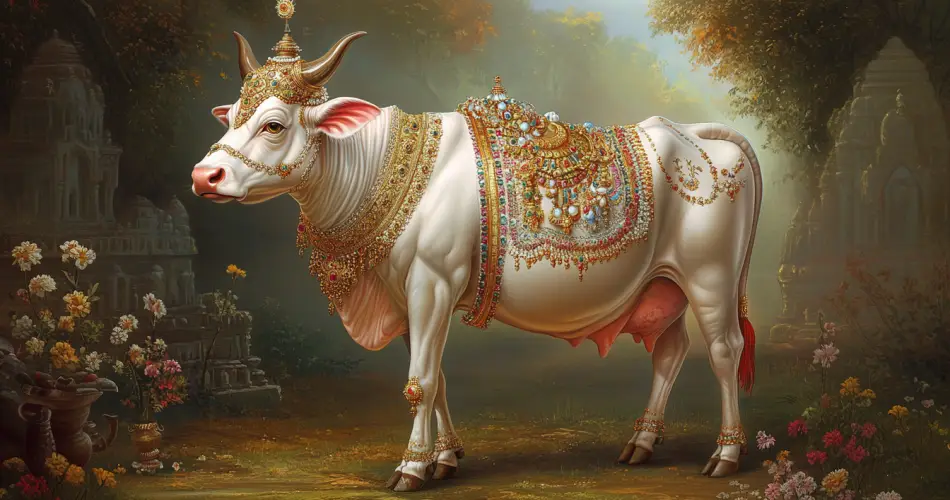What is Kamhadenu
Kamhadenu is a divine cow revered in Hinduism as the mother of all cattle and other bovine species. Her name in Hindu means “Cow of Plenty.”
The goddess symbolizes wealth, prosperity, and abundance. She is also depicted as the source of all material and spiritual riches.
Kamhadenu represents purity and non-erotic fertility. She is believed to be a mother goddess whose body contains all other deities within it. She is also associated with the fertile Mother goddess Privthi, who is also depicted as a cow.
Origin and birth of Kamhadenu
The Hindi Manuscripts disagree on the origin of the Kamhadenu. According to some records, the goddess was created from the agitation of Samudra Manthan, the cosmic milk ocean.
This was done by the gods(Devas) and the Demons (Asuras) in an effort to create the Amirite, a divine liquid that grants immortality.
However, apart from the amirite, the Kamhadenu was also born from the ocean. She was immediately presented to Brahma, the creator god, who commanded her to produce life-giving milk and supply it for ritual fire sacrifices.
Another Origin story for the Kamhadenu is told in the Devi Bhagavata Purana (one of the eighteen Mahapuranas of Hinduism). In this version, the god Krishna and his consort Radha were enjoying a casual romantic evening when they suddenly thirsted for milk.
To solve this problem, Krishna created the Kamhadenu from his own body and milked it. He was so pleased with the milk that he worshipped the creature and decreed that she would always be the provider of milk and prosperity to all who revered and respected her.
There are various other references to the Kamhadenu in the Hindu scripts. In some of these scripts, the Kamhadenu is said to be the daughter of Sage Rishsi Kashyapa and Krodhavasha.
Physical Appearance
The Kamhadenu is generally portrayed as a creature with the head and breast of a woman, the body of a cow, the wings of a bird, and the tail of a peafowl. Some other depictions of the goddess do not show her with the humanoid features.
The cow features of the Kamhadenu are very important in Hinduism, as different deities reside in various parts of her body.
For example, the four Vedas reside in the four legs of the creature, while the fire god Agni and the wind god Vayu are associated with the goddess’s right and left shoulders, respectively. Also, the sun and moon goddess reside in the eyes of the creature.
Finally, the horns of the Kamhadenu represent the Trimurti: Brahma (at the tip), Vishnu(at the middle), and Shiva (at the bottom), respectively.
The goddess is also shown with a calf suckling from her cow breasts, symbolizing her life-giving nature.
Powers and Abilities of Kamhadenu

The Kamhadenu can produce anything in the service of her master. She is closely associated with the priesthood class because of her ability to produce ghee, an important material used in Vedic ritual sacrifice. This is why she is sometimes referred to as the Homadhenu, “the cow from which Ablation are drawn.
In Hindu scriptures, the priesthood class are forbidden from indulging in violence of any kind. This restriction makes them easy targets for abusive kings who might want to take advantage of this. The Kamhadenu, in the service of the sages and priests, provides these priests with protection.
Read Also: Origin, deities, and mythical creatures in Hinduism.
According to one account, when her master Vasishtha got into a conflict with an abusive king, she produced various warrior peoples to defend her master.
The Kamboja warriors came from her mouth, Barvaras from her udder, Shakas and Yavanas from her anus, and the Haritas and Kiratas came from the pores of her skin.
Some Hindu accounts also believe that the cosmic milk ocean, which contains the essence of all good things on earth, came from the udder of this divine cow goddess.
Kamhadenu Stories in Hindu Scriptures
The Kamhadenu is mentioned in various ancient Hindu scripts. In many of these illustrations, the absolute loyalty of the goddess to her master is highlighted. In the epic Mahabharata, the Kamhadenu served Jamadagni, one of the seven Vedic sages.
According to the epic, the divine goddess and her calf are abducted by Kartavirya Arjuna. She is later rescued by Parashurama, the son of the sage. He defeated the king and returned the bovine goddess to his father.
Another mention of the Kamhadenu is seen in the Ramayana. Here it is said that the goddess lived with Lord Varuna -the lord of the sky and ocean) in his abode, which is located below the earth.
Why cows are not Eaten in India
In Hinduism, which is the largest religion in India, Cows and other bovine species are seen as the physical embodiment of the Kamhadenu. They are a representation of the abundance, divine care and nourishment provided by the goddess.
Also, since the goddess’s body is associated with various Hindu gods, consuming any part of the animal is considered an insult or disrespect.
Also, Hindu philosophy also emphasizes ahimsa (non-violence), a key tenet that discourages harm to living beings. As cows are associated with nurturing and life-giving qualities, harming or consuming them is seen as contradictory to this principle. Over time, this reverence for cows has transcended religious boundaries. It is now a significant part of Indian culture and influencing dietary practices across various communities.
